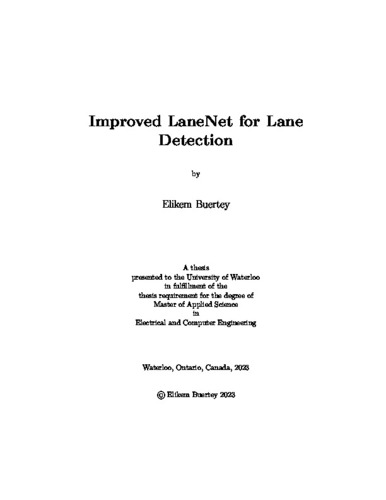| dc.contributor.author | Buertey, Elikem | |
| dc.date.accessioned | 2023-12-18 15:31:59 (GMT) | |
| dc.date.available | 2023-12-18 15:31:59 (GMT) | |
| dc.date.issued | 2023-12-18 | |
| dc.date.submitted | 2023-12-14 | |
| dc.identifier.uri | http://hdl.handle.net/10012/20170 | |
| dc.description.abstract | Lane detection is a critical component in autonomous vehicles and advanced driver assistance systems (ADAS), enabling accurate lane tracking and vehicle positioning. While traditional lane detection methods based on handcrafted features and heuristics have limitations in challenging environments, the adoption of machine learning (ML) techniques has shown promise. However, many existing ML models struggle with detecting a variable number of lanes, making them less effective in complex driving scenarios.
A simple solution involves the use of High Definition (HD) Maps. HD Maps offer comprehensive road information necessary for autonomous driving, but their high cost and inflexibility pose challenges for frequent updates and modifications. This research proposes an innovative approach, the Improved LaneNet (ILaneNet) network, to strike a balance between ML techniques and HD maps. By augmenting input images with a lane parameter namely the number of lanes, we aim to enhance lane detection accuracy without incurring the prohibitive costs of HD maps. ILaneNet seeks to achieve real-time precision in locating and tracking lane markings, even in challenging conditions like inadequate lighting and intricate road layouts.
The objective of this study is to develop a flexible, cost-effective, and robust lane detection system that adapts to diverse driving scenarios. By incorporating pertinent information into the network, we demonstrate improved adaptability and potential advancements in autonomous driving technologies. We also introduce new evaluation metrics namely capacity, lost capacity and unsafe driving measure to assess lane detection techniques more comprehensively. We also propose evaluation of lane detection techniques by using a lane abstraction approach instead of the traditional line abstraction method. Through extensive evaluation and comparisons, we showcase the superiority of ILaneNet over LaneNet in detecting lanes. This research contributes to bridging the gap between ML techniques and HD maps, offering a viable solution for effective and efficient lane detection in autonomous vehicles and ADAS. | en |
| dc.language.iso | en | en |
| dc.publisher | University of Waterloo | en |
| dc.relation.uri | https://github.com/TuSimple/tusimple-benchmark | en |
| dc.subject | ILanenet | en |
| dc.subject | Improved LaneNet | en |
| dc.subject | Lane Detection | en |
| dc.title | Improved LaneNet for Lane Detection | en |
| dc.type | Master Thesis | en |
| dc.pending | false | |
| uws-etd.degree.department | Electrical and Computer Engineering | en |
| uws-etd.degree.discipline | Electrical and Computer Engineering | en |
| uws-etd.degree.grantor | University of Waterloo | en |
| uws-etd.degree | Master of Applied Science | en |
| uws-etd.embargo.terms | 0 | en |
| uws.contributor.advisor | Naik, Sagar | |
| uws.contributor.affiliation1 | Faculty of Engineering | en |
| uws.published.city | Waterloo | en |
| uws.published.country | Canada | en |
| uws.published.province | Ontario | en |
| uws.typeOfResource | Text | en |
| uws.peerReviewStatus | Unreviewed | en |
| uws.scholarLevel | Graduate | en |

